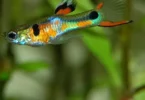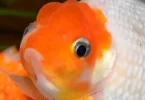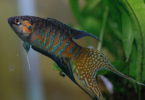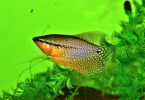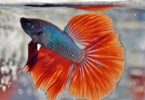Last Updated on February 10, 2023 by Matt
The Chili Rasbora (Boraras brigittae) is a species of fish that is commonly kept in the home aquarium. This species is known for its vibrant red color and its active personality, making it a popular choice among aquarium enthusiasts. If you’re considering adding chili rasboras to your tank, it’s important to learn about their care requirements so that you can provide them with the best possible environment.
In the wild, chili rasboras are found in slow-moving bodies of water, such as streams and rivers, in Southeast Asia. They prefer heavily-vegetated environments, and they are often found among dense stands of aquatic plants. In the home aquarium, it is important to recreate this environment to the best of your ability. This can be done by providing plenty of hiding spots, such as caves or dense vegetation, and by adding a slow-moving water filter to the tank.
Chili rasboras are relatively small fish, growing to an adult size of only about 1.5 centimeters. As such, they are best suited to smaller aquariums, such as those that hold 5 to 10 gallons of water. However, it is important to note that, like all fish, chili rasboras produce waste and will require adequate filtration to maintain good water quality. A hang-on-back or canister filter is typically sufficient for a tank of this size.
IN THIS ARTICLE
Appearance
The head of the Chili Rasbora is slightly rounded, with a small mouth and large, almond-shaped eyes. Their eyes are typically a bright red or orange color, which contrasts starkly with their dark body color. The fins of the fish are also red or orange, with the exception of the dorsal fin, which is slightly lighter in color and often has a pale edge. The tail fin is forked and also brightly colored, and its movement helps the fish maintain balance and stability as it swims.
The Chili Rasbora is known for its active swimming behavior, which is facilitated by its slender, streamlined body. As they move through the water, their scales reflect light and create a dazzling display of color and movement. They are social creatures and are often seen swimming in groups or shoals, further adding to the visual impact of their appearance.
Overall, the Chili Rasbora is a brightly colored and active species of freshwater fish that is notable for its striking coloration and graceful swimming behavior.
Lifespan
The average lifespan of a Chili Rasbora, also known as Boraras brigittae, is between 2 to 3 years. These small, colorful fish are popular among aquarium hobbyists for their peaceful demeanor and attractive appearance. However, like all living creatures, the length of their life can be influenced by a variety of factors such as genetics, water conditions, and diet.
Exact water Conditions
The Chili Rasbora is a small freshwater fish species that requires specific water conditions in order to thrive. They are native to slow-moving, nutrient-rich rivers and streams in Southeast Asia, and as such, they require a similar environment in captivity. The following is a detailed description of the water conditions required for Chili Rasbora:
Temperature: Chili Rasboras are comfortable in water temperatures between 75-82°F. It is important to maintain a consistent temperature within this range, as sudden changes in temperature can cause stress to the fish and negatively impact their health.
pH: The pH of the water should be between 6.0 and 7.5. This acidic to neutral pH range is ideal for the Chili Rasbora, as it simulates their natural habitat. Deviations from this range can affect the health and well-being of the fish.
Hardness: The hardness of the water, measured in terms of total dissolved solids, should be between 5-15 dKH. This range of water hardness is important for the health of the fish, as it helps to regulate the levels of dissolved minerals in the water.
Water Quality: The water in the environment of the Chili Rasbora should be clear and free of pollutants, such as excess nutrients and harmful chemicals. Regular water changes, along with proper filtration, can help maintain good water quality and support the health of the fish.
It is important to note that these are the ideal water conditions for Chili Rasboras, and deviations from these conditions can affect the health and well-being of the fish. Regular water testing and monitoring can help ensure that the water conditions remain within the optimal range for the species.
Diet
The Chili Rasbora is a small freshwater fish species that requires a balanced and varied diet in order to maintain good health and vitality. The following is a detailed description of the diet requirements for Chili Rasboras:
Protein: Chili Rasboras require a diet high in protein, which can be provided through a variety of protein-rich foods such as brine shrimp, daphnia, and bloodworms. These foods should make up a significant portion of their diet.
Plant Matter: In addition to protein, Chili Rasboras also require a source of plant matter in their diet. This can be provided through a variety of food sources, including spirulina, algae wafers, and blanched vegetables.
Variety: Chili Rasboras benefit from a varied diet that includes a variety of food types. This helps ensure that they are getting all of the nutrients that they need and helps to prevent boredom and nutritional deficiencies.
Feeding Frequency: Chili Rasboras should be fed small portions of food several times per day. Overfeeding can lead to a buildup of excess nutrients in the water, which can negatively impact the health of the fish.
It is important to note that the specific diet requirements for Chili Rasboras can vary based on factors such as their age, size, and overall health. Consulting with a veterinarian or aquarium specialist can help ensure that the fish are receiving a balanced and appropriate diet. Additionally, it is important to avoid feeding them food that is past its expiration date, as this can lead to malnutrition or other health issues.
Best tank mates for Chili Rasboras
The Chili Rasbora is a small freshwater fish species that is known for being peaceful and social. As such, they do well in community tanks with other similarly sized and peaceful species. The following is a detailed description of the best tank mates for Chili Rasboras:
Peaceful Fish: Chili Rasboras do best in tanks with other peaceful fish species, such as tetras, barbs, and danios. These species are similar in size and behavior to the Chili Rasbora and can help create a harmonious and stress-free environment.
Similar Water Requirements: It is important to choose tank mates that have similar water requirements to the Chili Rasbora. For example, species that prefer similar temperatures, pH levels, and water hardness will be more compatible with the Chili Rasbora.
Non-Aggressive Fish: It is important to avoid tank mates that are aggressive or territorial, as this can lead to stress and conflict within the tank. This includes species such as cichlids and large, predatory fish.
Shoaling Species: Chili Rasboras are social creatures and do best in groups, or shoals, of their own species. However, if a shoal of Chili Rasboras is not possible, they can do well with other shoaling species, such as tetras or danios.
It is important to note that these are general guidelines for the best tank mates for Chili Rasboras, and the specific tank mates that are best for any given individual may vary based on factors such as their size, behavior, and water conditions. It is always recommended to research and consult with a veterinarian or aquarium specialist to determine the best tank mates for your individual Chili Rasboras.
Here is a list of fish species that are commonly considered compatible tank mates for Chili Rasboras:
- Neon tetra
- Ember tetra
- Cardinal tetra
- Rummy nose tetra
- Dwarf gourami
- Guppies
- Platies
- Bamboo shrimp
- Amano shrimp
- Ghost shrimp
- Other peaceful rasbora species such as the Harlequin Rasbora or the Scissortail Rasbora
- Other peaceful small tetra species such as the GloFish or the Black Skirt Tetra
- Corydoras catfish species such as the Bronze or the Pepper Cory
- Other peaceful bottom-dwelling fish species such as the Siamese Algae Eater.
It is important to note that this is not an exhaustive list, and the specific compatibility of different fish species with Chili Rasboras may depend on factors such as water conditions, tank size, and the individual temperaments of the fish. It is always recommended to research and consult with a veterinarian or aquarium specialist before adding new fish to an established tank.
How to Breed Chili Rasboras
Chili Rasboras are a relatively easy species to breed in a controlled environment, although they may not breed spontaneously in the absence of specific environmental cues. The following is a detailed guide to breeding Chili Rasboras:
Water Conditions: Chili Rasboras require specific water conditions in order to trigger breeding behavior and ensure that the eggs and fry will develop properly. These conditions include a temperature between 75-79°F, a pH of 6.0-7.0, and a water hardness of 4-12 dGH.
Plant Cover: Chili Rasboras prefer to lay their eggs in areas with plenty of vegetation, so providing a densely planted tank or adding spawning mops can help encourage breeding.
Diet: A balanced and varied diet, high in protein and including a variety of food types, is essential for encouraging Chili Rasbora breeding.
Conditioning: Chili Rasboras should be conditioned for breeding by providing them with high-quality food and optimal water conditions. This process can take several weeks or even months and should include regular water changes and monitoring of water parameters.
Spawning: Once the fish are conditioned, they may begin to spawn. The females will lay their eggs on vegetation or other surfaces in the tank, and the males will fertilize the eggs. Depending on the species and the individual fish, a single spawning can produce anywhere from 20 to 200 eggs.
Fry Care: The eggs will hatch within a few days, and the fry will become free-swimming a few days after that. It is important to provide appropriate care for the fry, including feeding them small, nutritious food several times a day and maintaining optimal water conditions.
It is important to note that while Chili Rasboras are relatively easy to breed, success can still depend on several factors, including the quality and health of the breeding fish, the water conditions, and the availability of appropriate food and shelter for the eggs and fry. It is always recommended in our humble opinion to research and consult with a veterinarian or aquarium specialist before attempting to breed Chili Rasboras.
Key Diseases to watch out for:
Like all living organisms, Chili Rasboras are susceptible to a range of diseases that can affect their health and wellbeing. The following are some of the most common diseases that can afflict Chili Rasboras:
- Ich: Also known as “white spot disease,” Ich is a parasite that can cause white spots to form on the skin and fins of the fish. This disease is highly contagious and can be spread quickly from one fish to another in an aquarium environment.
- Fin Rot: Fin rot is a bacterial infection that can cause the fins of the fish to become frayed and discolored. It can be caused by poor water quality, overcrowding, or other environmental factors.
- Swim Bladder Disease: Swim bladder disease is a condition that affects the swim bladder, which helps the fish to maintain its balance and control its buoyancy. This disease can cause the fish to float upside down, swim erratically, or have difficulty swimming in general.
- Columnaris: Columnaris is a bacterial infection that can cause sores or ulcers to form on the skin and fins of the fish. It is often associated with poor water quality and high levels of stress.
- parasites: Chili Rasboras, like many other fish species, can be infected with a variety of parasites, such as flukes, tapeworms, and lice. These parasites can cause a range of symptoms, including poor appetite, lethargy, and skin irritation.
It is important to note that these are not the only diseases that can affect Chili Rasboras, and that different fish species and individuals may be susceptible to different diseases and conditions. To help prevent the spread of disease and promote the health and wellbeing of the fish, it is important to maintain optimal water conditions and provide appropriate care and nutrition. If you suspect that your Chili Rasbora is sick, deal with it quick!
Key Takeaways
Chili Rasboras are relatively flexible when it comes to water parameters and can thrive in a range of conditions. They prefer a pH level of 6.0 to 7.5, water hardness of 2 to 15 dKH, and a temperature range of 22 to 28 degrees Celsius. Regular water changes and testing are crucial for keeping the tank clean and free from excess waste. A 20% water change every 2 to 4 weeks is recommended. Before adding tap water to your tank, use a dechlorinator to remove any harmful chlorine or chloramine. As omnivores, Chili Rasboras will eat a variety of foods, including flakes, frozen, and live food. To ensure they’re getting a balanced diet, feed them a variety of food sources. When it comes to socializing, Chili Rasboras are peaceful and tend to do best in groups of 6 or more. They can be kept with other small, peaceful fish species.
It’s important to note that while Chili Rasboras are relatively low-maintenance, they still require proper care and attention to thrive. Regular water testing and maintenance, as well as proper feeding, are key to keeping your fish healthy. Chili Rasboras are also sensitive to water quality, so be sure to regularly check parameters such as pH, hardness, and temperature. To provide the best possible environment for your Chili Rasboras, consider adding a heater and a thermometer to your tank. This will help regulate the water temperature and keep your fish comfortable. Additionally, be sure to provide adequate hiding spots and vegetation for your fish to create a more natural environment.
In conclusion, taking proper care of your Chili Rasboras will ensure that they remain healthy and happy. Regular water changes and testing, proper feeding, and creating a suitable environment are all crucial components of their care. With the right setup and care, Chili Rasboras can bring life and color to your tank for many years to come.


